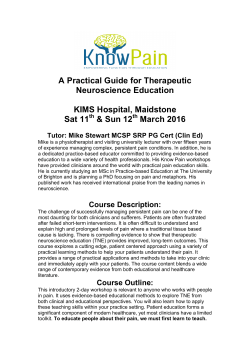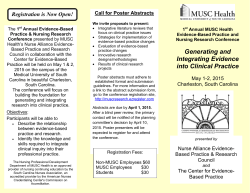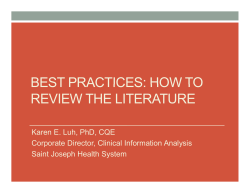
Evidence-based? Promising? What is the Difference and Why Does
Evidence-based? Promising? What is the Difference and Why Does it Matter? David W. Test & Ruth Allison National Technical Assistance Center on Transition Purposes • To overview concept of evidence-based practices (EBPs) • To overview different definitions for EBPs, including NTACT’s • To introduce NTACT’s Best Available Evidence Matrix • To introduce NTACT’s “Other Topic” annotated bibliographies Federal Mandates • NCLB (2001) requires schools ensure students have access to effective scientifically based instructional strategies and defines “scientifically based research” as “research that…involves the application of rigorous, systematic, and objective procedures to obtain reliable and valid knowledge relevant to education activities and programs”[20 U.S.C. § 7901(37)]. • IDEA (2004) calls for the use of scientifically based instruction with students with disabilities Federal Mandates (cont.) Workforce Innovation Opportunity Act (WIOA) allows for the implementation of evidence based findings to improve policy, procedure, practice, and the preparation of personnel in order to improve the transition of students with disabilities from school to postsecondary education or and employment outcome. [Proposed §361.48 (a)(3)(vi)] Scientifically Based Research (NCLB, 2001) The term “scientifically based research”• (A) means research that involves the application of rigorous, systematic, and objective procedures to obtain reliable, and valid knowledge relevant to education activities and programs: and • (B) includes research that• (i) employs systematic, empirical methods that draw on observation or experiment • (ii) involves rigorous data analyses that are adequate to test the stated hypothesis and justify the general conclusions drawn Scientifically Based Research (NCLB, 2001) • (iii) relies on measurements or observational methods that provide reliable and valid data across evaluators and observers, across multiple measurements and observations, and across studies by the same or different investigators: • (iv) is evaluated using experimental or quasiexperimental designs in which individuals, entities, programs, or activities are assigned to different conditions and with appropriate controls to evaluate the effects of the condition of interest, with a preference for random-assignment experiments, or other designs to the extent that those designs contain within-condition or across-condition controls: Scientifically Based Research (NCLB, 2001) • (v) ensures that experimental studies are presented in sufficient detail and clarity to allow for replication or, at a minimum, offer the opportunity to build systematically on their findings; and • (vi) has been accepted by a peer-reviewed journal or approved by a panel of independent experts through a comparably rigorous, objective, and systematic review. Council for Exceptional Children Published 3 special issues of Exceptional Children a. 2005; 71(2); quality indicators and criteria for EBPs* b. 2009; 75(3); examples of using quality indicators and EBP criteria c. 2013; 79(2); implementing and sustaining EBPs Other Terms.1 (US Office of Management and Budget, 2015) • “Evidence-Based” level is consistent with the What Works Clearinghouse standards and includes evidence based on randomized experimental methods or quasi-experimental strategies that use propensity matching or other strategies to insure a matched comparison group as well as meta-analyses of such studies. • “Evidence-Informed” level refers to evidence gathered through longitudinal studies and meta-analyses. Although the evidence is primarily correlational in nature, the evidence has either been demonstrated as stable over time or across multiple studies and is therefore deemed robust enough to make conclusions that can guide practice and policy-making efforts. • “Promising” level relies on correlational data that is consistent with existing theory. Other Terms.2 (RRTC on Evidence-Based Practice in VR) • Emerging offers knowledge about what works and does not work, but doesn’t have evaluation data to demonstrate its effectiveness( Puddy & Wilkens, 2011; Twyman & Sota, 2008) • Promising includes emerging practice elements and adds programmatic quantitative data that demonstrates positive outcomes, but doesn’t contain research data to support its replication (De Palma, 2002) • Evidence-based is a practice with statistical and clinical significance and encompasses emerging, to promising, to evidence-based (Driever, 2002) Other Terms.3 (What Works Clearinghouse, Version 3.0) • Rates studies as having: – – – – – – Positive effects Potentially positive No discernible effects Mixed effects Potentially negative effects Negative effects • Then determines “extent” of evidence (medium to large or small) based on # of studies, settings, and participants What are we talking about? – Terms are not at all consistent. – All combinations have been used: A B C Evidence Based Practice(s) Research Validated Treatment(s) Scientifically Empirically Program(s) Supported Intervention(s) – As a speaker and listener, remember: • Usage is NOT CONSISTENT across the field of education – We cannot assume anything from the term alone – We must attend to the procedures, not the label (Detrich, Spencer, & Slocum, 2009) Levels of Practice (Helsel, Hitchcock, Miller, Malinow, & Murray, 2006; Twyman, 2008) Evidence-Based Practices • Are based on rigorous research designs • Have demonstrated a record of success for improving student outcomes • Have undergone systematic review process using quality indicators to evaluate level of evidence Research-Based Practices • Are based on rigorous research designs • Have demonstrated a record of success for improving student outcomes Promising Practices Unestablished Practices • Are based on research • Have demonstrated limited success • Have used a ‘weak’ research design • Are not based on research • Have no data to support effectiveness • Based on anecdotal evidence and/or professional judgment How Do You Identify an EBP, RBP, PP,…? • Start by identifying a “practice.” • Horner et al. (2005) defined it as “A practice refers to a curriculum, behavioral intervention, systems change, or educational approach designed for use by…with the express expectation that implementation will result in measurable educational, social, behavioral, or physical benefit.” (p. 175). ID'ing Practices continued… • Once a practice is identified, it can be useful to also identify a DV and the target population • For example: “The use of video modeling to teach job skills to students with cognitive disabilities.” • Doing this will help narrow the coming literature search Once You Have Reviewed the Literature and Identified Articles That Meet Your Inclusion Criteria, How do You Decide if it is Evidence-Based? • First, you must determine the quality of the research studies that used the practice – See NTACT’s Quality Indicator Checklists for group, single-subject, correlational, and qualitative research (ask us) • Then, you must determine if you have enough studies to meet some standard – See NTACT’s Definitions for Levels of Evidence (presented later) Now that that is clear, let’s muddy the water a bit… • The field is now talking about “evidence-based practice” as a way of doing business, as a decision-making process. For example… RRTC on EBP in VR Evidence Based Practice (EBP): “…should involve the integration of the best and most current research evidence with clinical/educational expertise and relevant stakeholder perspectives in the pursuit of making the best possible decisions for a particular consumer.” From: Integrating Research into VR Practice: A guide to integrating research into Vocational Rehabilitation Practice (2015) http://www.research2vrpractice.org/training/EBPintoVRPracticePUB2/index.htm RRTC on EBP in VR 4 steps to Integrating Research into VR Practice: 1. Formulate well-defined, answerable questions 2. Seek the best evidence available to answer your questions 3. Critically evaluate the evidence 4. Apply the evidence to your individual consumer From: Integrating Research into VR Practice: A guide to integrating research into Vocational Rehabilitation Practice (2015) http://www.research2vrpractice.org/training/EBPintoVRPracticePUB2/index.htm Evidence-Based Practice… …is a decision-making process that integrates: – Top-tier research – Relevant experience-based knowledge – Current policy for improving outcomes for children and youth with disabilities and their families (Buysse, Wesley, Snyder, & Winton, 2006; Turnbull et al., 2010) Another Definition Evidence-Based Practice is a process of making decisions informed by four sources of influence: a) frameworks or principles b) best available research evidence c) professional judgment d) student needs and values (Detrich, Spencer, & Slocum, 2009) So, is Evidence-Based Practice a “Noun” or a “Verb”? • Noun = an intervention; based on high quality research; an evidence-based practice; Slocum et al. (2014) used the term “Empirically Supported Treatment” • Verb = a way of acting; Evidence-based practice; evidence-informed practice • Either way, where should a professional start? With a practice that has shown a greater chance of success, or with a practice where outcomes are unknown? What is NTACT Doing About EBPs? Teaching practitioners to use evidence-based practice (as a verb; as a way of acting) by providing practitioners with access to the best available evidence on practices (as a noun; a specific practice) that ensure all students with disabilities are prepared to succeed in postsecondary education and employment. Best Available Evidence Matrix (see handout) Level of Evidence Secondary Special Education Evidence-based Practices • Are based on rigorous research designs • Have demonstrated a record of success for improving student outcomes • Have undergone systematic review process using quality indicators to evaluate level of evidence • • Research-based Practices • Are based on rigorous research designs • Have demonstrated a record of success for improving student outcomes • • VVocational Rehabilitation • 1 Student-Focused Planning 5 Student-Development (Life Skills) (NSTTAC, Practice Descriptions) 1 Student-Focused Planning 26 Student-Development (Academic, Employment, and Life Skills) (NSTTAC, Practice Descriptions) • 6 Predictors (e.g., inclusion, paid employment) (NSTTAC, Predictor Resources) Graduation/ School Completion/ Dropout Prevention Career and Technical Education and Career Development 10 Dropout Prevention Programs (e.g., Check & Connect, RENEW) (Wilkins & Huckabee, 2014. NDPC-SD, Literature Map) • Counseling and working alliance between counselor and consumer • Skills training • Supported Employment (for people with ID/DD and severe mental illness; individual placement and support model; IPS) • Overall Effect of VR Interventions (Journal of Vocational Rehabilitation, 2014) • Counseling and working alliance between counselor and consumer • Skills training • Supported Employment (for people with ID/DD and severe mental illness; individual placement and support model; IPS) • Overall Effect of VR Interventions (Journal of Vocational Rehabilitation, 2014) Criteria for Levels of Evidence (see handout) Evidence-Based Practice Group Experimental Design • • • Single-Case Design • • • Correlational • • • • 1 Two high quality1 or a combination of four high and acceptable quality2 studies using rigorous research designs demonstrating positive effects Studies must calculate effect size or report data that allows for calculation There is no evidence from a high or acceptable quality study demonstrating negative effects A combination of five high3 or acceptable4 quality studies using rigorous research designs demonstrating a functional relation Three independent research teams There is no evidence from a high or acceptable quality study demonstrating negative effects Two high quality a priori (planned, hypothesis stated) studies5 demonstrating consistent significant correlations between predictor and outcome variables Studies must use high quality6 propensity score modeling/matching Studies must calculate effect size or report data that allows for calculation There is no evidence from a high a priori study demonstrating negative correlations between predictor and outcome variables High quality group experimental study must meet 1, 2, 3, 4, 6, 8, 9 & 10 and 5 or 7 of EQIs and at least 4 of the DQIs Quality Indicator Checklist for Group Experimental Research 2 Acceptable quality group experimental study must meet 1, 2, 3, 4, 6, 8, 9 & 10 and 5 or 7 of EQIs and at least 1 of the DQIs Must calculate effect size or report data that allows for calculation Quality Indicator Checklist for Group Experimental Research 3 High quality single-case study meets all quality indicators Quality Indicator Checklist for Single-Case Research 4 Acceptable quality single-case study meets all QIs except 2 & meets one of 17-20 Quality Indicator Checklist for Single-Case Research 5 High quality a priori studies must meet all quality indicators for correlational research 6 High quality propensity score modeling studies must meet all quality indicators for correlational research Other Topics (see handout) • • • • • • • • • • • • • • • • • • • • • • Literature Review/ Resource Identification Other Topics Professional Development/ Technical Assistance/ Coaching Data-based decision making – student level/ systems level Collaboration/Consultation/Co-teaching Universal Design for Learning (UDL) Peer Supports Positive Behavioral Interventions and Supports (PBIS) -secondary level Response to Intervention (RTI) - secondary level Interagency Collaboration Academic Instruction – secondary level Mental Health Culturally Responsive Instruction Business Connections Family Engagement and Family Expectations Assistive Technology College Ready Programs Assessment Practices – career, statewide data Healthcare Transportation Supporting Students with Complex Support Needs Pre-Employment Transition Services What are we doing with the “Other Topics”? • Updating or creating Annotated Bibliographies for each topic • Creating 1-2 page summaries for each topic, with links to possible resources Your Turn! • Will the Best Available Evidence Matrix be useful? • What more is needed to support implementation of these practices? • What additional “Other Topics” are needed? Thank You! David W. Test: dwtest@uncc.edu Ruth Allison: rallison@transcen.org
© Copyright 2025









